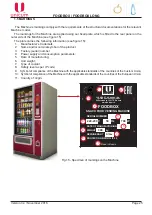
FOODBOX / FOODBOX LONG
Version 3.4 / November 2016
Page 15
1.4.4 RIELDA lock set
Locks type RiELDA allow you to program the lock to the correct set of keys, what makes it possible to
use one working key for multiple locks RiELDA and easily change the combination of the lock under the
new working key with loss, theft or damage to the old key.
The lock comes complete with three keys (see. figure 5):
- one master key - GOLDEN key is used only for the lock programming;
- two operating SiLVER key - used for opening / closing machine door.
Fig. 4
The lock can be located in two positions:
• operating position (‘‘closed’’ position - see figure 4);
• position for the programming (the ‘‘open’’ position - see figure 4);
The machine is supplied with pre-programmed lock. To open / close the door machine, insert the oper-
ating SiLVER
(see figure 5) key lock and turn it in the lock 90 degrees to the right to marry (see figure 4).
WARNING! Programming lock operations must be performed only when the machine
door is open! Otherwise, there will be lock (lock) the door latch.
Control risk
Closed
Open/programming
90
0
Master key
Working keys
Fig. 5
To program the lock by other working key (for example, to use one working key for multiple machines
or operating loss of key) you must perform the following operations when you open the door machine:
• Insert the master key lock (‘‘closed’’ position - see figure 4) in which the castle was the last time that
programmed or is supplied with a lock (for primary programming). Lock master key in the lock at least
one second. Then turn 90 degrees in the direction of the control key risk (see figure 4).
•
While holding shutting off device of the door in order to avoid a spontaneous turn of the lock, remove
the master key from the lock and insert them into the new master key , which you want to program
the lock.if you want to program the lock on the same master key, don’t remove the master key from
the lock.
• Then turn the master key 90 degrees in the opposite direction (the ‘‘closed’’ position -see figure 4).
















































